NVIDIA’s GeForce GTX 480 and GTX 470: 6 Months Late, Was It Worth the Wait?
by Ryan Smith on March 26, 2010 7:00 PM EST- Posted in
- GPUs
Compute
Update 3/30/2010: After hearing word after the launch that NVIDIA has artificially capped the GTX 400 series' double precision (FP64) performance, we asked NVIDIA for confirmation. NVIDIA has confirmed it - the GTX 400 series' FP64 performance is capped at 1/8th (12.5%) of its FP32 performance, as opposed to what the hardware natively can do of 1/2 (50%) FP32. This is a market segmentation choice - Tesla of course will not be handicapped in this manner. All of our compute benchmarks are FP32 based, so they remain unaffected by this cap.
Continuing at our look at compute performance, we’re moving on to more generalized compute tasks. GPGPU has long been heralded as the next big thing for GPUs, as in the right hands at the right task they will be much faster than a CPU would be. Fermi in turn is a serious bet on GPGPU/HPC use of the GPU, as a number of architectural tweaks went in to Fermi to get the most out of it as a compute platform. The GTX 480 in turn may be targeted as a gaming product, but it has the capability to be a GPGPU powerhouse when given the right task.
The downside to GPGPU use however is that a great deal of GPGPU applications are specialized number-crunching programs for business use. The consumer side of GPGPU continues to be underrepresented, both due to a lack of obvious, high-profile tasks that would be well-suited for GPGPU use, and due to fragmentation in the marketplace due to competing APIs. OpenCL and DirectCompute will slowly solve the API issue, but there is still the matter of getting consumer orientated GPGPU applications out in the first place.
With the introduction of OpenCL last year, we were hoping by the time Fermi was launched that we would see some suitable consumer applications that would help us evaluate the compute capabilities of both AMD and NVIDIA’s cards. That has yet to come to pass, so at this point we’re basically left with synthetic benchmarks for doing cross-GPU comparisons. With that in mind we’ve run a couple of different things, but the results should be taken with a grain of salt as they don’t represent any single truth about compute performance on NVIDIA or AMD’s cards.
Out of our two OpenCL benchmarks, we’ll start with an OpenCL implementation of an N-Queens solver from PCChen of Beyond3D. This benchmark uses OpenCL to find the number of solutions for the N-Queens problem for a board of a given size, with a time measured in seconds. For this test we use a 17x17 board, and measure the time it takes to generate all of the solutions.
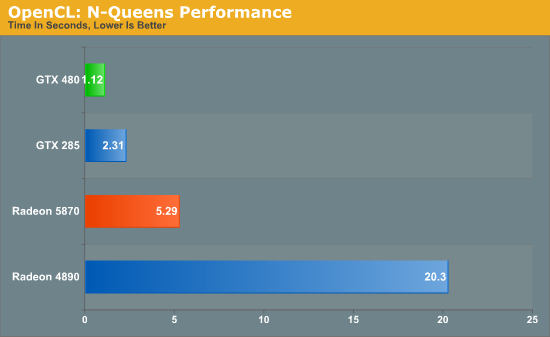
This benchmark offers a distinct advantage to NVIDIA GPUs, with the GTX cards not only beating their AMD counterparts, but the GTX 285 also beating the Radeon 5870. Due to the significant underlying differences of AMD and NVIDIA’s shaders, even with a common API like OpenCL the nature of the algorithm still plays a big part in the performance of the resulting code, so that may be what we’re seeing here. In any case, the GTX 480 is the fastest of the GPUs by far, beating out the GTX 285 by over half the time, and coming in nearly 5 times faster than the Radeon 5870.
Our second OpenCL benchmark is a post-processing benchmark from the GPU Caps Viewer utility. Here a torus is drawn using OpenGL, and then an OpenCL shader is used to apply post-processing to the image. Here we measure the framerate of the process.
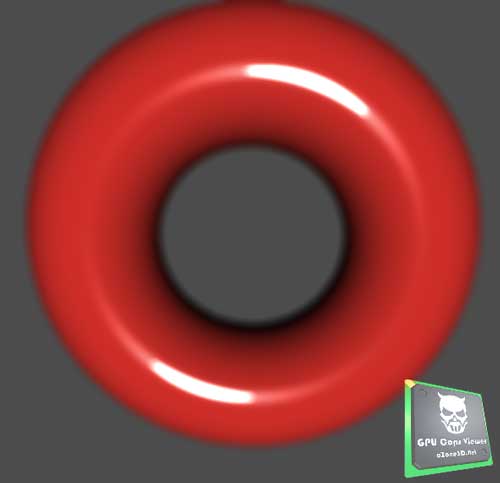
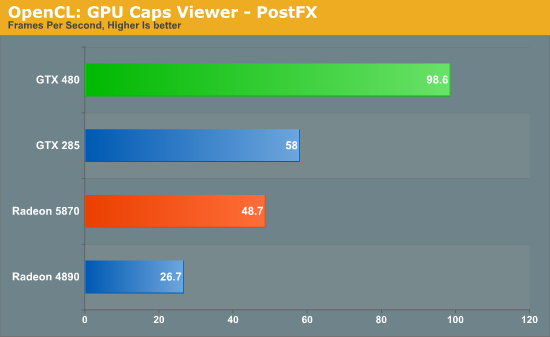
Once again the NVIDIA cards do exceptionally well here. The GTX 480 is the clear winner, while even the GTX 285 beats out both Radeon cards. This could once again be the nature of the algorithm, or it could be that the GeForce cards really are that much better at OpenCL processing. These results are going to be worth keeping in mind as real OpenCL applications eventually start arriving.
Moving on from cross-GPU benchmarks, we turn our attention to CUDA benchmarks. Better established than OpenCL, CUDA has several real GPGPU applications, with the limit being that we can’t bring the Radeons in to the fold here. So we can see how much faster the GTX 480 is over the GTX 285, but not how this compares to AMD’s cards.
We’ll start with Badaboom, Elemental Technologies’ GPU-accelerated video encoder for CUDA. Here we are encoding a 2 minute 1080i clip and measuring the framerate of the encoding process.
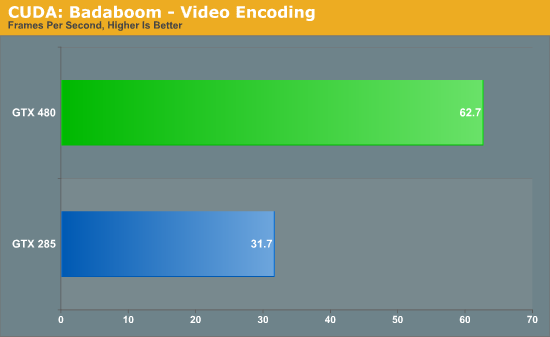
The performance difference with Badaboom is rather straightforward. We have twice the shaders running at similar clockspeeds, and as a result we get twice the performance. The GTX 480 encodes our test clip in a little over half the time it took the GTX 280.
Up next is a special benchmark version of Folding@Home that has added Fermi compatibility. Folding@Home is a Standford research project that simulates protein folding in order to better understand how misfolded proteins lead to diseases. It has been a poster child of GPGPU use, having been made available on GPUs as early as 2006 as a Close-To-Metal application for AMD’s X1K series of GPUs. Here we’re measuring the time it takes to fully process a sample work unit so that we can project how many nodes (units of work) a GPU could complete per day when running Folding@Home.

Folding@Home is the first benchmark we’ve seen that really showcases the compute potential for Fermi. Unlike everything else which has the GTX 480 running twice as fast as the GTX 285, the GTX 480 is a fewtimes faster than the GTX 285 when it comes to folding. Here a GTX 480 would get roughly 3.5x as much work done per day as a GTX 285. And while this is admittedly more of a business/science application than it is a home user application (even if it’s home users running it), it gives us a glance at what Fermi is capable when it comes to compuete.
Last, but not least for our look at compute, we have another tech demo from NVIDIA. This one is called Design Garage, and it’s a ray tracing tech demo that we first saw at CES. Ray tracing has come in to popularity as of late thanks in large part to Intel, who has been pushing the concept both as part of their CPU showcases and as part of their Larrabee project.

In turn, Design Garage is a GPU-powered ray tracing demo, which uses ray tracing to draw and illuminate a variety of cars. If you’ve never seen ray tracing before it looks quite good, but it’s also quite resource intensive. Even with a GTX 480, with the high quality rendering mode we only get a couple of frames per second.
On a competitive note, it’s interesting to see NVIDIA try to go after ray tracing since that has been Intel’s thing. Certainly they don’t want to let Intel run around unchecked in case ray tracing and Larrabee do take off, but at the same time it’s rasterization and not ray tracing that is Intel’s weak spot. At this point in time it wouldn’t necessarily be a good thing for NVIDIA if ray tracing suddenly took off.
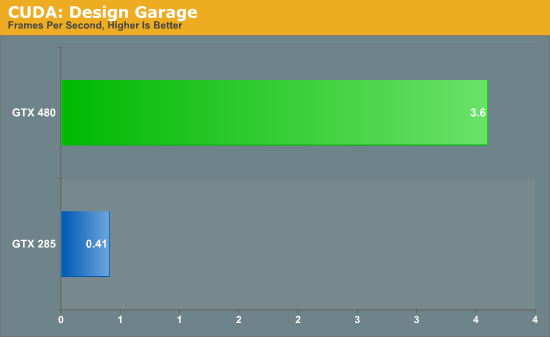
Much like the Folding@Home demo, this is one of the best compute demos for Fermi. Compared to our GTX 285, the GTX 480 is eight times faster at the task. A lot of this comes down to Fermi’s redesigned cache, as ray tracing as a high rate of cache hits which help to avoid hitting up the GPU’s main memory any more than necessary. Programs that benefit from Fermi’s optimizations to cache, concurrency, and fast task switching apparently stand to gain the most in the move from GT200 to Fermi.










196 Comments
View All Comments
henrikfm - Tuesday, March 30, 2010 - link
Now it would be easier to believe only idiots buy ultra-high end PC hardware parts.ryta1203 - Tuesday, March 30, 2010 - link
Is it irresponsible to use benchmarks desgined for one card to measure the performance of another card?Sadly, the "community" tries to hold the belief that all GPU architectures are the same, which is of course not true.
The N-queen solver is poorly coded for ATI GPUs, so of course, you can post benchmarks that say whatever you want them to say if they are coded that way.
Personally, I find this fact invalidates the entire article, or at least the "compute" section of this article.
Ryan Smith - Wednesday, March 31, 2010 - link
One of the things we absolutely wanted to do starting with Fermi is to include compute benchmarks. It's going to be a big deal if AMD and NVIDIA have anything to say about it, and in the case of Fermi it's a big part of the design decision.Our hope was that we'd have some proper OpenCL/DirectCompute apps by the time of the Fermi launch, but this hasn't happened. So our decision was to go ahead with what we had, and to try to make it clear that our OpenCL benchmarks were to explore the state of GPGPU rather than to make any significant claims about the compute capabilities of NVIDIA or AMD's GPUs. We would rather do this than to ignore compute entirely.
It sounds like we didn't make this clear enough for your liking, and if so I apologize. But it doesn't make the results invalid - these are OpenCL programs and this is what we got. It just doesn't mean that these results will carry over to what a commercial OpenCL program may perform like. In fact if anything it adds fuel to the notion that OpenCL/DirectCompute will not be the great unifier we had hoped for them to be if it means developers are going to have to basically write paths optimized around NVIDIA and AMD's different shader structure.
ryta1203 - Tuesday, March 30, 2010 - link
The compute section of this article is just nonsense. Is this guy a journalist? What does he know about programming GPUs?Firen - Tuesday, March 30, 2010 - link
Thanks for this comprehensive review, it covers some very interesting topics betwen Team Green and Team Red.Yet, I agree with one of the comments here, you missed how easy that ATI 5850 and 5870 can be overlocked thanks to their lite design, a 5870 can easily deliver more or less the same performance as a 480 card while still running cooler and consumes less power..
Some people might point out that our new 'champion' card can be overlocked as well..that's true..however, doesn't it feel terrifying to have a graphic card running hotter than boiling water!
Fulle - Tuesday, March 30, 2010 - link
I wonder what kind of overclocking headroom the 470 has.... since someone with a 5850 can easily bump the voltage up a smidge, and get about a 30% overclock with minimal effort... people who tinker can usually safely reach about 1GHz core, for about a 37% overclock.Unless the 470 has a bit of overclocking headroom, someone with a 5850 could easily overclock to have superior performance, lower heat, lower noise, and lower power consumption.
After all these months and months of waiting, Nvidia has basically released a few products that ATI can defeat by just binning their current GPUs and bumping up the clockspeed? *sigh* I really don't know who would buy these cards.
Shadowmaster625 - Tuesday, March 30, 2010 - link
You're being way too kind to Nvidia. Up to 50% more power consumption for a very slight (at best) price/performance advantage? This isnt a repeat of the AMD/Intel thing. This is a massive difference in power consumption. We're talking about approximately $1 a year per hour a week of gaming. If you game for 20 hours a week, expect to pay $20 a year more for using the GTX470 vs a 5850. May as well add that right to the price of the card.But the real issue is what happens to these cards when they get even a modest coating of dust in them? They're going to detonate...
Even if the 470 outperformed the 5850 by 30%, I dont think it would be worth it. I cant stand loud video cards. It is totally unacceptable to me. I again have to ask the question I find myself asking quite often: what kind of world are you guys living in? nVidia should get nothing more than a poop-in-a-box award for this.
jujumedia - Wednesday, March 31, 2010 - link
with those power draws and the temps it reaches for daily operation i see gpu failure rates high on the gtx 480 and 470 as they are already faulty from the fab lab. Ill stick with ATI for 10 fps less.njs72 - Wednesday, March 31, 2010 - link
I been holding on for months to see what Fermi would bring in the world of GPUs. After reading countless reviews of this card i dont think its a justifyable upgrade for my gtx260. I mean yeah the performance is much higher but in most reviews of benchmarks with games like Crysis this card barely wins against the 5870, but buying this card i would need to upgrade the psu and posibly a new case for ventilation. I keep loading up Novatechs website and and almost adding a 5870 to the basket, and not pre ordering gtx480 like i was intending. What puts me off more than anything with the new nvidia card is its noise and temps. I cant see this card living for very long.Ive been a nvidia fan ever since the the first geforce card came out, which i still have tucked away in a draw somewhere. I find myself thinking of switching to ATI, but read too many horror stories about their driver implementation that puts me off. Maybe i should just wait for Nvidia to refresh its new card and keep hold of my 260 for a bit longer. i really dont know :-(
Zaitsev - Wednesday, March 31, 2010 - link
There is an error with the Bad Company 2 image mouse overs for the GTX 480. I think the images for 2xAA and 4xAA have been mixed up. 2xAA clearly has more AA than the 4xAA image.Compare GTX 480 2x with GTX 285 4x and they look very similar. Also compare 480 4x with 285 2x.
Very nice article, Ryan! I really enjoyed the tessellation tests. Keep up the good work.